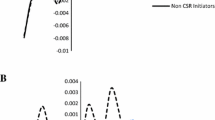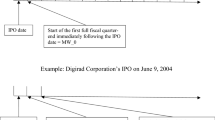Abstract
We attempt to understand the personal incentives that motivate corporate insiders to engage in unethical behavior such as delayed trade disclosure. Delayed disclosure affects corporate transparency and other shareholders in the firm potentially suffer investment losses because they are unaware of insiders’ activities. Using archival data from the 300 largest Australian firms between 2007 and 2011, the results show that risk factors such as insider age and tenure and wealth effects in the form of insider shareholdings affect the likelihood of delayed reporting. Governance positions such as committee membership mitigate this behavior. Our study highlights the importance of considering individual insider’s wealth and risk factors. The self-monitoring role of governance positions is also indicative of the effectiveness of internal corporate governance in the prevention of illegal insider behavior.
Similar content being viewed by others
Notes
This is only true in a positive law regime (where government creates rights that did not exist previously). In a negative rights regime, the rights of these shareholders are not violated because they have no rights to information that does not belong to them. That is, there is no legal or moral duty to disclose. We thank the anonymous reviewer for bringing this point to our attention.
The late reported trade metric is measured by number of shares. To ensure that stock splits are detected, the beginning and end balances of insider stockholdings (in terms of number of shares) are compared for each financial year. Furthermore, such close examination of the beginning and year end stockholding balances allows us to re-estimate net late reported trading each year such that any late reported trading in one financial year is not carried over into the next year. For each reported trade, particularly those conducted near the end of the financial year, a 15 trading day allowance is made for the reporting of the trade. This is due to the s205G disclosure requirement allowing directors to report up to 14 days after the trade.
The censoring at the lower limit of 500 shares resulted in the reduction of 120 cases while at the upper end, the figure was 53.
Firms in the sample were allocated into size deciles based on market capitalisation, where Decile 1 consists of the smallest firms and Decile 10 the largest firms. Small firms are defined as those belonging to Deciles 1, 2, and 3 while large firms belong in Deciles 8, 9, and 10.
Experience is not significant in the executive director-large firm regression.
References
Armstrong, C. S., Larcker, D. F., Ormazabal, G., & Taylor, D. J. (2013). The relation between equity incentives and misreporting: the role of risk-taking incentives. Journal of Financial Economics, 109, 327–350.
Beams, J. D., Brown, R. M., & Killough, L. N. (2003). An experiment testing the determinants of non-compliance with insider trading laws. Journal of Business Ethics, 45, 309–323.
Beasley, M. S. (1996). An empirical analysis of the relation between the board of director composition and financial statement fraud. Accounting Review, 71, 443–465.
Becker, G. S. (1968). Crime and punishment: An economic approach. Journal of Political Economy, 76, 169–217.
Bergstresser, D., & Philippon, T. (2006). CEO incentives and earnings management. Journal of Financial Economics, 80, 511–529.
Berle, A. A., & Means, G. G. C. (1932). The modern corporation and private property. New York: Macmillan.
Bhattacharya, U., & Marshall, C. D. (2012). Do they do it for the money? Journal of Corporate Finance, 18, 92–104.
Bommer, M., Gratto, C., Gravander, J., & Tuttle, M. (1987). A behavioral model of ethical and unethical decision making. Journal of Business Ethics, 6, 265–280.
Brick, I. E., Palmon, O., & Wald, J. K. (2006). CEO compensation, director compensation, and firm performance: evidence of cronyism? Journal of Corporate Finance, 12, 403–423.
Carpenter, J. N. (2000). Does option compensation increase managerial risk appetite? The Journal of Finance, 55, 2311–2331.
Cheng, S., Nagar, V., & Rajan, M. V. (2007). Insider trades and private information: the special case of delayed-disclosure trades. Review of Financial Studies, 20, 1833–1864.
Cheng, Q., & Warfield, T. D. (2005). Equity incentives and earnings management. The Accounting Review, 80, 441–476.
Clinard, M. B. (1983). Corporate ethics and crime: The role of middle management. Beverly Hills: Sage Publications.
Etebari, A., Tourani-Rad, A., & Gilbert, A. (2004). Disclosure regulation and the profitability of insider trading: Evidence from New Zealand. Pacific-Basin Finance Journal, 12, 479–502.
Fama, E. F. (1980). Agency problems and the theory of the firm. The Journal of Political Economy, 88, 288–307.
Fama, E. F., & Jensen, M. C. (1983). Separation of ownership and control. Journal of Law and Economics, 26, 301–325.
Fich, E. M., & Shivdasani, A. (2007). Financial fraud, director reputation, and shareholder wealth. Journal of Financial Economics, 86, 306–336.
Fidrmuc, J. P., Goergen, M., & Renneboog, L. (2006). Insider trading, news releases, and ownership concentration. The Journal of Finance, 61, 2931–2973.
Givoly, D., & Palmon, D. (1985). Insider trading and the exploitation of inside information: Some empirical evidence. Journal of Business, 58, 69–87.
Helland, E. (2006). Reputational penalties and the merits of class-action securities litigation. Journal of Law and Economics, 49, 365–395.
Huddart, S., Hughes, J. S., & Levine, C. B. (2001). Public disclosure and dissimulation of insider trades. Econometrica, 69, 665–681.
Jensen, M. C., & Meckling, W. H. (1976). Theory of the firm: Managerial behavior, agency costs and ownership structure. Journal of Financial Economics, 3, 305–360.
Katz, R. (1982). The effects of group longevity on project communication and performance. Administrative Science Quarterly, 81–104.
Kesner, I. F. (1988). Directors’ characteristics and committee membership: An investigation of type, occupation, tenure, and gender. Academy of Management Journal, 31, 66–84.
King, G., Tomz, M., Zeng, L. (1999). RELOGIT: rare events logistic regression, Version 1.1. Harvard University, Cambridge, MA. http://gking.harvard.edu/. (October 1).
King, G., Zeng, L. (1999). Logistic Regression in Rare Events Data. Department of Government, Harvard University. http://GKing.Harvard.Edu.
Lakonishok, J., & Lee, I. (2001). Are insider trades informative? Review of Financial Studies, 14, 79–111.
Li, H., Henry, D., & Chou, H. I. (2011). Stock market mispricing, executive compensation and corporate Investment: Evidence from Australia. Journal of Behavioral Finance, 12, 131–140.
Lipton, M., & Lorsch, J. W. 1992. A modest proposal for improved corporate governance. The Business Lawyer, 57–59.
MacCrimmon, K. R., & Wehrung, D. A. (1990). Characteristics of risk taking executives. Management Science, 36, 22–435.
McGee, R. W. (2009). Analyzing insider trading from the perspectives of utilitarian ethics and rights theory. Journal of Business Ethics, 91, 65–82.
Miller, D. (1991). Stale in the saddle: CEO tenure and the match between organization and environment. Management Science, 37, 34–52.
Morck, R., Shleifer, A., & Vishny, R. W. (1988). Management ownership and market valuation: An empirical analysis. Journal of Financial Economics, 20, 293–315.
Peterson, D., Rhoads, A., & Vaught, B. C. (2001). Ethical beliefs of business professionals: A study of gender, age and external factors. Journal of Business Ethics, 31, 225–232.
Pool, V., Wang, C., & Xie, F. 2009. Corporate Scandal, Director Reputation and Shareholder Value: Ex-post Settling Up, Spillover and Distraction. Unpublished working paper. Indiana University.
Roulstone, D. T. (2003). The relation between insider-trading restrictions and executive compensation. Journal of Accounting Research, 41, 525–551.
Rozeff, M. S., & Zaman, M. A. (1998). Overreaction and insider trading: Evidence from growth and value portfolios. The Journal of Finance, 53, 701–716.
Seyhun, H. N. (1988). The information content of aggregate insider trading. Journal of Business, 61, 1–24.
Smith, C. W., & Stulz, R. M. (1985). The determinants of firms’ hedging policies. Journal of Financial and Quantitative Analysis, 20, 391–405.
Steen, A., & Horrigan, W. (1995). Self-serving behaviour amongst company directors: An Australian investigation. Corporate Governance: An International Review, 3, 30–37.
Terpstra, D., Reyes, M., & Bokor, D. (1991). Predictors of ethical decisions regarding insider trading. Journal of Business Ethics, 10, 699–710.
Terpstra, D. E., Rozell, E. J., & Robinson, R. K. (1993). The influence of personality and demographic variables on ethical decisions related to insider trading. The Journal of Psychology, 127, 375–389.
Trevino, L. K. (1986). Ethical decision making in organizations: A person-situation interactionist model. Academy of Management Review, 11, 601–617.
Vafeas, N. (2003). Length of board tenure and outside director independence. Journal of Business Finance & Accounting, 30, 1043–1064.
Vroom, V. H., & Pahl, B. (1971). Relationship between age and risk taking among managers. Journal of Applied Psychology, 55, 399.
Wolfe, D., & Hermanson, D. R. (2004). The fraud diamond: Considering four elements of fraud. The CPA Journal, 74, 38–42.
Author information
Authors and Affiliations
Corresponding author
Rights and permissions
About this article
Cite this article
Chang, M., Lim, Y. Late Disclosure of Insider Trades: Who Does It and Why?. J Bus Ethics 133, 519–531 (2016). https://doi.org/10.1007/s10551-014-2413-3
Received:
Accepted:
Published:
Issue Date:
DOI: https://doi.org/10.1007/s10551-014-2413-3




